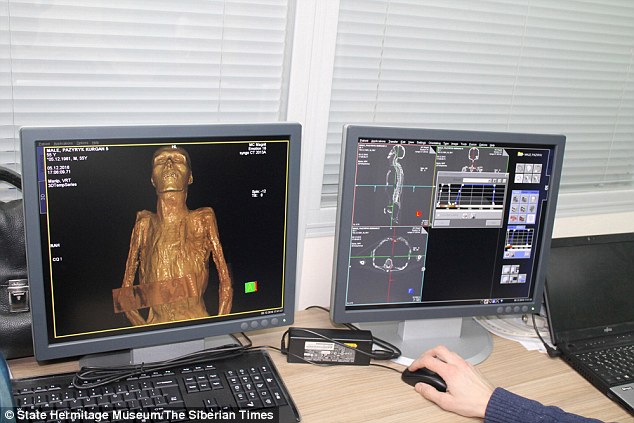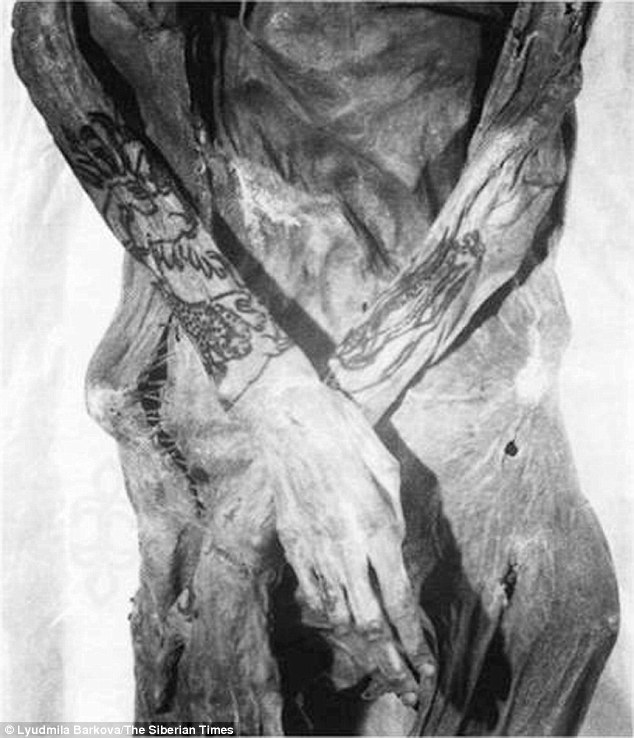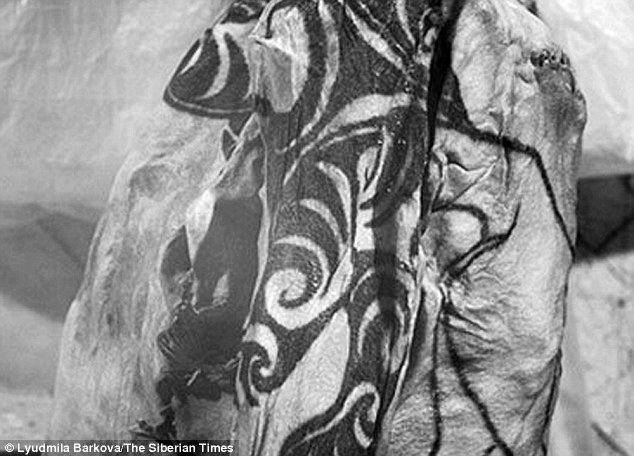An ancient chieftain couple who owned the world’s oldest carpets are undergoing their first medical check in 2,200 years to throw new light on their lives as prehistoric Siberian potentates.

The tattooed Altai Mountain royals were entombed in ice in their burial mound, preserving their remains for thousands of years until Soviet archeologists excavated the site in the Stalin era.
But now modern technology being used to obtain secrets of the life and death of these mummies, believed to be a curly-haired chieftain and his pig-tailed wife or concubine.
The remains of the chieftain couple have been held in the world famous Heritage Museum in St Petersburg since 1949. But researchers have now scanned the bodies to reveal details about their lives

PAZYRYK PEOPLE
The Pazyryk people were part of an Iron Age archaeological culture in the 6th to 3rd centuries BC.
The Pazyryk archaeological culture belongs to the steppe archeological category, which is sometimes named ‘Scythian’.
Their remains have been found in the Siberian permafrost in the Altay Mountains and nearby Mongolia.
As well as their belongings, their bodies have preserved some of the best ancient tattoos ever seen in the world.
They were believed to be skilled surgeons and had knowledge of the Hippocratic Corpus, a set of ancient Greek medical texts

Their mummified bodies have undergone scans with the latest medical technology and now the tomograph images will be studied by radiologists, biological anthropologists, archaeologists and other scientists.
‘The aim is to establish the cause of death, reconstruct the appearance of the ancient pair, and to study the techniques of mummification in more detail,’ according to one account.
The remains have been held in the world famous Hermitage Museum in St Petersburg since 1949.

The couple are famous for both the elaborate tattoos on their skin and also the two oldest carpets in the world which include remarkable images of the life of the ancient Pazyryk culture in Siberia several hundred years before the birth of Christ.
Most treasures were from the grave – inside a burial mound 137ft in diameter – were robbed in the deep past.
The mummified bodies have undergone scans with the latest medical technology and now the tomograph images will be studied by radiologists, biological anthropologists, archaeologists and other scientists
The couple are famous for the elaborate tattoos on their skin. The woman has no tattoos on her shoulders, but many on her forearms
On the man’s shoulder, the tattoos depict a feline predator, probably a tiger, and a horse
The couple owned two of the oldest carpets in the world which include remarkable images of the life of the ancient Pazyryk culture in Siberia several hundred years before the birth of Christ
One of the carpets – 21 ft by 15 ft – was probably a wall hanging before being used as part of the burial ceremony
THE TATTOOS
The tattoos depict a feline predator, probably a tiger, and a horse on the man’s shoulder.
On the forearm of the right hand is an Asiatic wild ass or horse and some predator with a striped tail.
On his hands are images of birds, including a grouse of capercaillie.
On the man’s legs, below the knee, are tattooed groups of ungulates.
The images depict only real animals, seen as unusual for Pazyryk remains, when often fantastical creatures have been found in tattoos.
The woman has no tattoos on her shoulders, but many on her forearms.
On her left arm is a predatory bird, killing a deer or moose. On her hand is a cock: she, too, only had real animals depicted on her skin.
On her left forearm is a complicated – and unusual for this culture – scene with two tigers and a snow leopard attacking deer and moose.
But the carpets, older than the couple and woven in the 5th century BC, remained as did a wooden chariot with large wheels, presumably used in the funeral rite.
Archeologists found evidence of cannabis being burned in their tomb as they were dispatched to the afterlife, and nine geldings, saddled and harnessed, were also sacrificed and placed in the tomb.

Soviet archeologist Sergey Rudenko – who led the excavation – wrote after his discovery of the ancient larch sarcophagus: ‘Both the man and woman were of Caucasoid type.
‘Their hair was soft, the man’s a little curly and dark. The woman’s dark brown.
‘Their faces were long and narrow, the man had a sharply protruding aquiline nose.
‘The man’s head, except for the back, was shaved.
‘The woman’s head was also shaved, except that on top was a pigtail. ‘
As part of the mummification process, the couple’s brains were removed by trapanation – brilling a hole in the skull.
The carpet was decorated with multi-colour applique including sewn figures more than 3ft metre in height, carved from fine coloured felt.
The images depict only real animals, seen as unusual for Pazyryk remains, when often fantastical creatures have been found in tattoos
On the forearm of the right hand is an Asiatic wild ass or horse and some predator with a striped tail
On the man’s legs, below the knee, are tattooed groups of ungulates, which the researchers were able to recreate (pictured right)
‘Through a slice in the abdomen, from the ribs to the groin, the intestines were removed,’ he said.
One of the carpets – 21 ft by 15 ft – was probably a wall hanging before being used as part of the burial ceremony.
It was decorated with multi-colour applique including sewn figures more than 3ft metre in height, carved from fine coloured felt.
The two carpets found alongisde the chieftain couple include remarkable images of the life of the ancient Pazyryk culture in Siberia
While most treasures from the grave were robbed in the deep past, the carpets, which were older than the couple and woven in the 5th century BC, remained
‘The central scene shows a rider approach a throne on which is seated a goddess with a flowering branch in her hand,’ reported The Siberian Times.
The tattoos depict a feline predator, probably a tiger, and a horse on the man’s shoulder.
On the forearm of the right hand is an Asiatic wild ass or horse and some predator with a striped tail.
On his hands are images of birds, including a grouse of capercaillie.
On the hem of one of the carpets was a pattern made up of repeated figures on horseback
A wooden chariot with large wheels, presumably used in the funeral rite, also remained alongside the couple and the carpets
The tattooed Altai Mountain royals were entombed in ice in their burial mound, preserving their remains for thousands of years until Soviet archeologists excavated the site in the Stalin era
On the man’s legs, below the knee, are tattooed groups of ungulates.
The images depict only real animals, seen as unusual for Pazyryk remains, when often fantastical creatures have been found in tattoos.
The woman has no tattoos on her shoulders, but many on her forearms.
On her left arm is a predatory bird, killing a deer or moose. On her hand is a cock: she, too, only had real animals depicted on her skin.
On her left forearm is a complicated – and unusual for this culture – scene with two tigers and a snow leopard attacking deer and moose.
The mummified bodies were discovered during the Stalin era. Pictured is the excavation of the site
The tattoos on the man’s hands depict images of birds, including a grouse of capercaillie
The couple lived in the Altai Mountain, where they were entombed in ice in their burial mound



